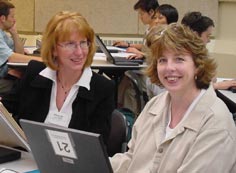The improved version of the objective is in the right column.
The type of the improved objective is shown [in red in square brackets].
|
|
|
Example Needing Improvement
|
Improved
|
|
a. Students will use basic survival language.
|
Students will use the verb "gustar" in the present tense to express food likes/dislikes (e.g., "Me gusta X; No me gusta Y")
[language objective]
Students will use the polite form of "querer" (quisiera) to order a meal in a role play.
[language objective]
|
|
b. Students will learn the alphabet.
|
Students will identify words beginning with the letter "p" in the context of X poem.
[content objective]
|
|
|
|
Example Needing Improvement
|
Improved
|
|
a. Students will be able to recognize and identify numbers (1-10) and be able
to trace or write these numbers in printed form.
|
Students will be able to identify written numbers.
[content objective]
Students will be able to identify a written number in relationship to the number of objects it represents.
[content objective]
Students demonstrate knowledge of the numbers 1-10 by writing them in relationship to the number of objects they represent.
[content objective]
Students will be able to trace the numbers 1-10 accurately.
[skills objective] |
b. Students will become familiar with structure and purpose of letters
and will create a short letter based on a modeled example. |
Students will identify the major components of a personal letter (date, greeting, body, closing).
[content objective]
Students will demonstrate understanding of the purpose of personal letters.
[content objective]
Students will demonstrate their understanding of a letter’s major components by writing a short personal letter based on a model.
[content objective]
Students will identify differences between French and U.S. letter-writing styles.
[cultural objective]
Students will use the present, past, and future tenses to write a short letter to an imaginary host family to introduce themselves with verbs like “to be,” “to like,” “to do,” “to have,” etc.
[language objective] |
|
|
|
Example Needing Improvement
|
Improved
|
|
a. Students will know what a fairy tale is.
|
Students will identify the literary characteristics of a fairy tale.
[content objective]
|
|
b. Students will be able to combine knowledge from previous class (read a play)
and apply it to writing their own play. [this is a larger goal that
can be broken down into objectives]
|
Students will be able demonstrate their knowledge of the components of a play
by including them (e.g., setting, props, characters) in writing a class
play.
[content objective]
Students will use their prior knowledge of plays in writing an original one.
[learning strategy
objective]
|
c. Students will say the key words.
|
Students will use key words (XXX) to identify the objects they represent.
[language/vocabulary/possibly content if related to content concepts] |
|
|
|
Example Needing Improvement
|
Improved
|
|
a. Teach the names of shapes.
|
Students will demonstrate their knowledge of basic shapes by correctly identifying
by name 5 basic shapes.
[content objective]
|
|
|
|
Example Needing Improvement
|
Improved
|
|
a. Students will introduce family members.
|
Students will use words/phrases such as c’est, voilá, and voici to introduce family members.
[language objective] |
b. Students will listen to German exchange students talk about U.S. schools. |
Students will identify perceptions of U.S. schools from viewpoints shared by
German exchange students.
[cultural objective]
|
c. Students will create a bar graph showing population growth. |
Students will demonstrate their knowledge of presented information on population
growth by creating a bar graph.
[content objective] |
d. Students will transfer information from group presentations to paper. |
Students will demonstrate understanding of the content of group presentations.
[content objective]
Students will practice active listening skills by completing an informational
chart (or taking notes) during group presentations.
[skills development objective]
|
e. Students will make predictions. (listed as a language objective) |
Students will make predictions while reading the text.
[learning strategy objective]
Students will use the present tense in the first person singular with
verbs like “I think” and the future tense (3rd person Sing/plural) to
make predictions.
[language objective - note that additional verbs to be used in the future tense will be determined by the text being read] |
|
Example Needing Improvement |
|
a. Students will introduce family members. (This only identifies the function but not the grammatical structures and vocabulary necessary for carrying the function out.) |
Students will use the present tense and words/phrases such as c’est, voilà, and voici to introduce family members.
[language objective] |
b. Students will give oral presentations. (macro-level) |
Students will use the preterit and imperfect tenses of regular verbs and irregular verbs to give an oral presentation on the history report (vocabulary will depend on the content being presented).
[language objective]
Students will use logical connectors to sequence events in an oral presentation (e.g., first, then, next, afterwards, finally).
[language objective]
Students will use key content vocabulary to make oral presentations. (vocabulary would be listed)
[language objective] |
Make sure that the objective corresponds to the correct category (this often
depends on the focus of the objective). See, for example, objective 5d. All
of the improved objectives above are identified by category.
The connection between objectives and activities should be very clear. In fact,
there should be a clear alignment between standards, objectives, activities,
and assessment. This tends to occur more easily with content and cultural
objectives, but the language and skills/learning strategy objectives also
need to emerge clearly in the activities as described.

